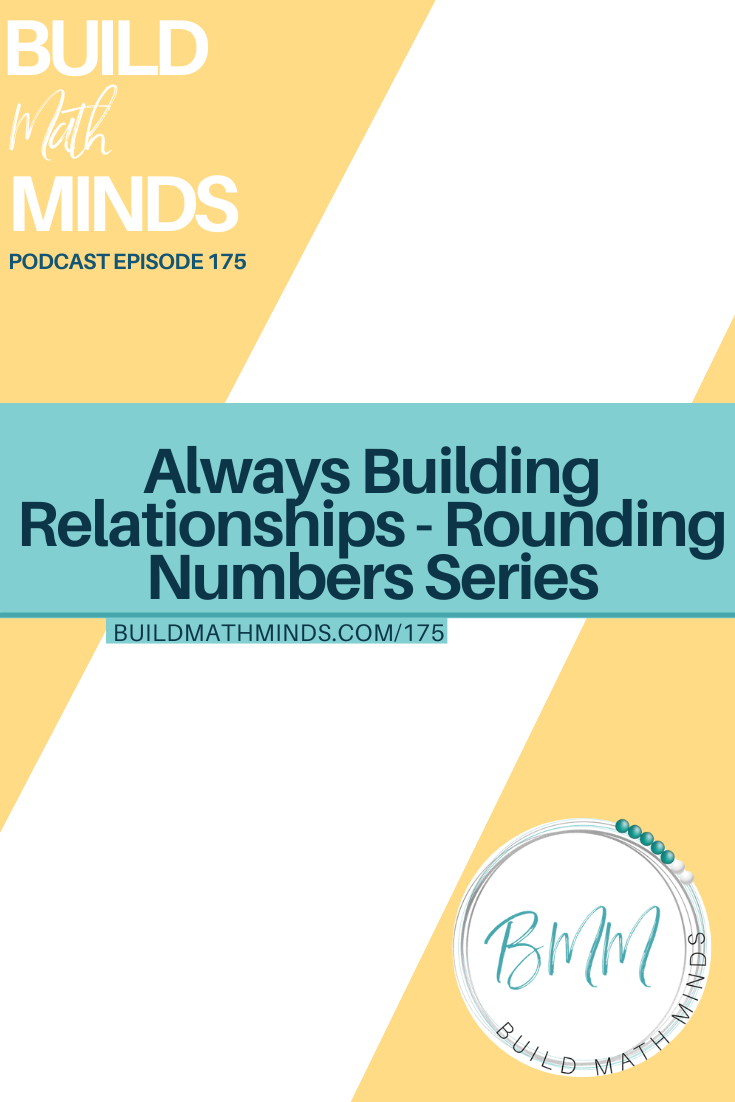Welcome fellow Recovering Traditionalists to Episode 175: Always Building Relationships – Rounding Numbers Series
This is my last episode in the rounding numbers series that was prompted by a question that was sent in to me. Here is what was sent in: “Some of my kiddos have trouble telling me which tens a number is between. For example, I’ll give them 53 and ask them to round it, but they can’t say it’s between either 50 or 60.”
As I talked about in the previous episodes this issue is rooted in the fact that kids are seeing numbers in isolation and haven’t built relationships around numbers. We can’t jump into rounding if students haven’t spent time exploring how numbers relate to each other because that’s all that rounding really is.
Rounding is usually taught as a Place Value concept where you teach kids the procedure of looking at the digit in the specified place but that is just another procedure for kids to follow and doesn’t really build their math minds.
My first tip for helping your students with rounding and that was to do lots of work with number lines and number paths. If you missed that episode, go back and listen to it…it was number 173. My second tip, in episode 174, was to do lots of work helping them understand the magnitude of a number.
And my last tip here in this episode is that in everything you do during math time I want you to be ABR: Always Building Relationships.
In the past two episodes I’ve given you activities you can do with students, and I’ll give you another one in this episode, but the key to helping students with understanding numbers so they can use that understanding to round numbers is to always be building relationships around numbers no matter what activity you are doing.
Helping students see relationships between numbers should NOT just be something we do during Number Routines. It should be happening all throughout math class. As a traditional math teacher my only questions to my students were typically focused on answer-getting. As a Recovering Traditionalist, we should use questions that focus on relationship-building. Here are ten example questions that you can use all the time, no matter what math activity you are doing that will help you get your students to focus on relationship-building not just answer-getting:
-
- What patterns do you notice?
- What’s the difference between these two strategies? Do you see anything the same in both strategies?
- If you know ______, does that help you with figuring out ________?
- How are these two the same? How are they different?
- How does ______ compare to _________?
- What would happen to the product if we double this number?
- What would happen if….?
- How could we break these numbers apart to make them easier to work with?
- What do you notice that might make this problem easier to work with?
- Have we ever solved a problem like this before?
- How does ______ relate to ______?
- Is this a reasonable answer?
Use these throughout your math time so that you are ABR-ing. Remember that acronym: ABR – Always Building Relationships.
The more students see how numbers relate, the easier it is to round a number because they are so used to relating numbers to each other. Rounding is all about a number’s proximity to other numbers and so we need to be doing lots of activities that help students see that. The more time they spend investigating how one number is closer to a higher or lower number the better they will be at doing that exact thing when rounding.
In the other two episodes I did in this series I gave you an activity and here’s another great Number Routine that will help your students build relationships between numbers. We recently released the Mystery Number Routine inside the Build Math Minds site for our members to use and it has students focus on how one number is closer to a higher or lower number. If you aren’t a member you can make your own.
Here’s an example of the Mystery Number for the early grades

But here’s an example for fractions as well.

To make your own, pick a number and then create 3-5 clues that you will give to students one at a time. This routine heavily focuses on how numbers relate to each other and is a great one to use to get started with ABR.
Throughout this Rounding Numbers series I hope you’ve seen how important building your students’number sense is so thatthey naturally see what numbers are closest to the given number for rounding. Now even though this episode was specifically about how building number relationships helps students with rounding, ABR is important for helping students with all mathematical concepts.
If you are a member of the Build Math Minds PD site, you have access to this Mystery Number document and a lot more routines to help your students build number relationships. If you aren’t a member, go over to BuildMathMinds.com/BMM to join.
I hope this helped build your math mind so you can build the math minds of your students. Don’t forget to be ABR-ing – Always Building Relationships. See you next week.




